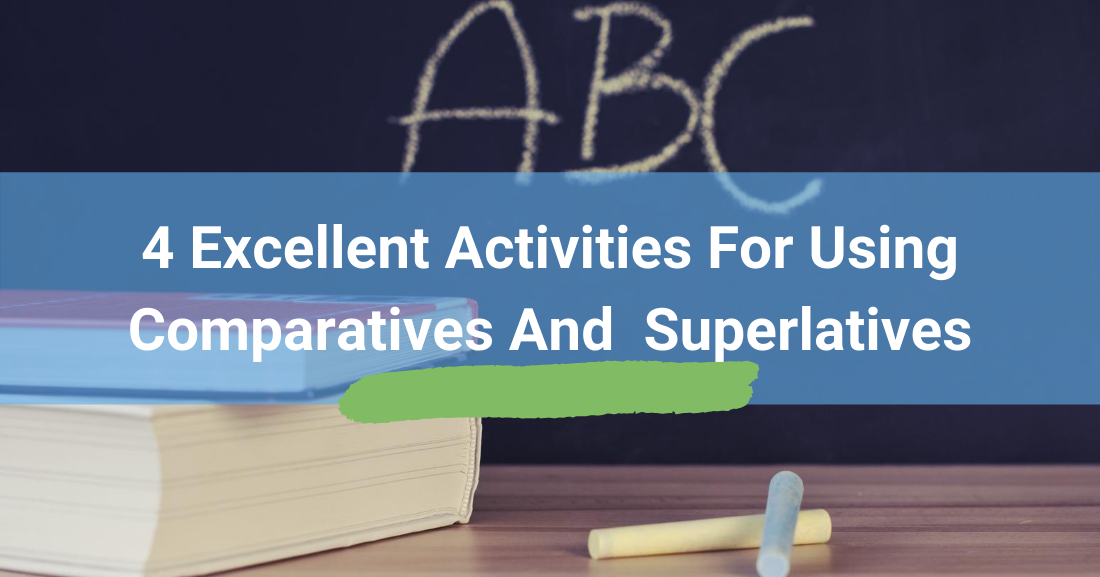Bigger, brighter, better, best…comparative and superlative adjectives are all around us in English.

We use these adjectives to compare items, express preferences and give value judgments. Once your students have a strong grasp on adjectives, and this should happen in beginning level ESL classes, you can move their knowledge to the next level by tackling the harder world of comparatives and superlatives.
Why do we use them?
We use comparatives and superlatives to say how people or things are different.
Comparative adjectives are used to compare two people or things.
We use comparative adjectives to compare one noun to another noun. In this case, only two items are compared. For example, you can say that "the red balloon is higher than the green balloon."
Superlative adjectives are used to compare more than two people or things.
We use superlative adjectives to compare thre or more nouns. We also use them to compare one thing against the rest of a group. Superlative adjectives demonstrate a higher level of comparison between entities. For example, "She's the fastest runner in all the team."

The Structure
The structure of comparative and superlative adjectives in English is quite simple. When comparing two comparative adjectives, add –er to the adjective to express superiority. This holds true for any adjectives that are one or two syllables. For three syllable adjectives, use “more” to express the comparison.
- She is smarter (than him).
- She is more beautiful (than him).
- It is the longest book (that we have read).
- It is the most complicated formula (that we will learn).
Try These Activities for Using Comparatives and Superlatives
-
1
Look Around You Race
Start with a simple activity right where you are by having students compare the people in your classroom. Put students in groups of four and then set a time limit of about five minutes. On your signal, each group should write as many comparative and superlative statements about the people in the room as they can. At the end of the time period, have one group share their sentences. If another group has the same sentence as the first group, both groups should cross that statement off their list. Continue until all groups have read all of their statements and any duplicates are eliminated. The group with the most statements remaining wins.
-
2
These Are the People in Your Family
Give your students 10 adjectives that can be used to describe people. You may want to include adjectives like old, young, tall, fat, happy, funny, etc. Then challenge them to write a sentence using the superlative form of each adjective. The sentence should be about a person in their family. Once the sentences are completed, each person should write a list of the family members who appeared in their sentences. Pairs of students should then exchange lists of people but keep their sentences to themselves. Each person should ask questions about their partner’s family and try to match each person to their superlative adjective. For example, a person might ask, “Is Su-Jan the oldest person in your family?” The other person should answer with a yes or an explanation. “No, Su-Jan is only four years old.” Give your groups ten to fifteen minutes to ask each other questions, and then see who in your class figured out the most family member qualities!
-

-
3
Home Style Interview
If your ESL class consists of students who have travelled overseas to study English, they probably have a strong opinion on how life in the U.S., U.K or Australia is different from that of their home country. Have students interview one another, you can do this in front of the class if you like, and ask about how life is different here than it was at home. Encourage students to use the comparative and superlative as much as possible during their interview. For example, a student might say “People here are busier, but life at home is slower.” If you like, have each person follow the activity by writing a paragraph about his own experience living overseas or that of his partner.
-
4
The "Most" Students
Do you remember your high school year book and the list of the “most” students in the back?
- The best smile
- The most artistic
- The smartest
- The most likely to succeed
- The person with the least accent
- The person who is the most adventurous eater
- The person who uses the dictionary most
-
5
Board Game
Board games are always a fun way to learn. They encourage teamwork, help students to make friends, and reinforce vocabulary and language skills. Play this Comparatives Board Game with your class to practice comparatives.
-
6
Visual Experience
Videos and worksheets that include such visual aids help engage students in the learning experience. They are also useful for memory retention and to reinforce the content. Try using this one in your next class Movie Worksheet: World Knowledge Quiz (Comparatives and Superlatives).
-
7
Color In
Children can begin learning Comparatives and Superlatives with this basic worksheet that explains comparatives and superlatives using simple vocabulary (animals and family). Coloring in is a great way to engage different parts of the brain and help make meaningful mental connections between concepts.
Comparatives and superlatives are simple English structures that give students and teachers lots of room for creativity and humor in the ESL classroom.
When you teach or review comparatives and superlatives, make it fun for your students.
What comparative and superlative activities do you use to bring fun into the classroom?
P.S. If you enjoyed this article, please help spread it by clicking one of those sharing buttons below. And if you are interested in more, you should follow our Facebook page where we share more about creative, non-boring ways to teach English.






